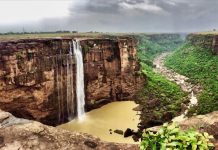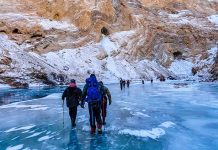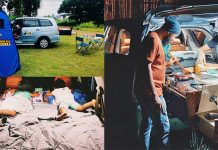A girl who dedicated her life for the forest, living behind the joyous city life
She is India’s only woman wildlife photographer to have permanently gone over to the other side — the wild side. She dumped her well-paying job to move to the Nilgiri jungles, where she’s lived for the past three years, capturing untamed nature on lens. Malavika Velayanikal spent three days with Vasudha Chakravarthi in the jungle and lived to tell the tale.
The road to her home is no road at all. It is just a steep, narrow clearing into the jungle. Only tough jeeps can manoeuvre the dirt-track — choked with rocks, boulders, sudden hairpin curves, with deep, green gorges waiting to swallow any lax vehicle. Her house — Hunting Lodge, a 187-year-old red mud, stone and wooden cottage — sits atop a hill, facing the Nilgiris, in relative solitude broken only by tuskers, bisons, sloth bears, and leopards.
Vasudha Chakravarthi is the only woman photographer in India who has been living in the jungle, soaking in the Nilgiri biosphere, and capturing it on lens religiously for the last three years.
Vasudha — meaning mother Earth in Sanskrit — lives a life far from ordinary. This Bangalore girl left a more-than-comfortable life in the city and a well-paying corporate job to follow her passion for wildlife, literally to the extreme.
Finding life’s purpose
“A documentary changed my life. I was in Calcutta in 2007 when I watched a film about clouded leopards. I wasn’t even aware of that species. A little research online, and I find that there are hardly any left. This piece of news triggered a deep sense of loss, a pain that we are losing something immeasurable. This got me thinking about my purpose in life.”
Vasudha’s journey into the wild began at Light and Life Academy, Ooty, where she learnt nature photography. Earlier, in Bangalore, she had assisted National Award-winning filmmaker VK Prakash, and also worked with a few cinematographers. She moved with her family to Kolkata and travelled around North-East India, where she explored wildlife, and recorded it. “This experience reignited a passion which I had developed as a child when the late Krishna Narain, a naturalist who was instrumental in shaping Bannerghata Wildlife Park, introduced me to nature. He showed me its beauty and taught me to value it,” Vasudha says. The one-year course at the Academy had Vasudha marking her territory — the Nilgiri biosphere.
She chose it for a reason. “This bioreserve is home to a wide range of forests — moist deciduous forests, montane rainforests, dry deciduous forests, semi-evergreen moist forests, thorn forests and scrub, grasslands, and ever-green forests. It houses over a hundred species of mammals, 350-plus species of birds, and more than 3,000 kinds of flora.”
What better way to explore the forests than through the tribals! She took up a house with the Soliga tribe in Bandipur. Initially, the tribals mistrusted her — a petite, 5-foot tall, 40-kg girl on a man’s bike. A generous friend, impressed by Vasudha’s passion, had gifted her a sturdy steed — a Yamaha Enticer. But in three months, they took her in as one of their own. The forests were opening up to her as well.
Vasudha also got acquainted with other tribes — Jenu Kurubas, Kurumbas, Irulas, and Badagas. She has been learning valuable lessons from them. Ones that came handy inside the forests: lessons in tracking and listening. “In the jungle, ears are more important than the eyes. Eyes will only see what is in front, but ears will cover all 360 degrees,” she says.
Sifting needs from wants
Her gear is just the bare essentials. No high-end trekking shoes or protective clothing. “Just chappals will do for me.” Sometimes she goes barefoot. “If a tribal can walk, track, and watch animals, why do I need something more?” she asks. That’s another lesson.
She learnt to distinguish between wants and needs — that meant dumping a lot of things, lifestyle choices, and even people. “I kept the needs, let go of the wants.”
Her stride soon became almost feline. She could walk so stealthily, not a leaf rustling to alarm the animals. She climbs up trees, sneaks inside bamboo clusters, and if a sudden pang of hunger strikes, clambers up thorny orange trees, and snacks on citrus fruits. She has fallen off many trees, but has never broken any bones. She did suffer many scratches and countless tick bites though. The severest of her injuries were a few stitches when her jeep overturned at one of the hairpin bends.
Never once in these three years has she missed Bangalore. “I miss home food. Here, I come back at sunset, exhausted, and I have to cook if I have to eat. Warm, tasty food, that’s all I miss.”
Vasudha’s pictures are distinctive, never the staccato wildlife photograph. All her images have a dreamy feel, and drama to it.
That’s her interest in cinematography playing out. While out, she always carries her 17-kg camera kit, but isn’t always prowling for a shoot. For her, the experience of sighting wildlife is more thrilling than arresting it on lens.
“I see pugmarks, footprints, or scats and realise that the animal is around. Then I wait. I study its habits closely before shooting. You need to sight the animal first, before it sights you.”
Animals smell humans instantly. Vasudha has her way of misleading the fauna. In dangerous territory, she smears elephant dung on her body, which camouflages all human scent!
September 22, 2008, is unforgettable for her. She was hiding inside a bamboo cluster, watching a tusker munching grass.
Suddenly, the elephant stiffened and stood alert, staring straight ahead. It took Vasudha a moment to realise what threatened the animal. A tigress was on the other side, heading to where the tusker was. “A loud growl from her, followed by an even fiercer trumpeting from the elephant. I froze as I was seeing a territorial fisticuff between two beautiful creatures,” Vasudha recalls.
Her most dangerous experience was again with elephants. Three elephants charged at her from three directions. “I had no choice but to speed my jeep straight up to a dead-end and wait until the elephants left me alone.”
Vasudha is well aware of her weaknesses. She doesn’t have the state-of-the-art equipment that most wildlife photographers bank on. To overcome this, “I go real close. Many times, eye to eye with my subject.” But she is careful never to disturb it. “I know I am the intruder, trespassing into the animal’s territory. So I take care not to offend,” she says.
Meet the pachyderm
Over the years, her senses have sharpened. A twig breaking gives away the animal to her now. She can sense animals at night outside her house. This reporter got a first-hand experience of it the first night of her stay in Kalhati.
It was close to eight at night, music was playing on her computer, and we were talking. Vasudha was showing us her work, when she suddenly froze, and stopped mid-sentence. “There’s a tusker outside,” she said, before even looking out. Feline-like, she gracefully slid to the window, and gasped. I stood up to see, and there he was — the biggest pachyderm I ever saw. With tusks at least three feet long. He had grass in his mouth, and he stared straight at us. He didn’t seem to like what he saw, just turned and left.
“This is life,” Vasudha said.
Vasudha Chakravarthi found her identity rather circuitously. A college dropout by choice, she faced outrage and anger from many quarters when she embarked on her search for meaning in life. Her stint at an international bank, earning good money, proved something to the world outside, but wasn’t enough for her.
She travelled to Assam, and rediscovered herself in Kaziranga. Doggedly, she chased her dream, and is now ‘settled’ at her perch, in the jungle, soaking in nature — animals, insects, snakes and all of it. “So here I am,” she says, “at 30, living in Nilgiris, serving my purpose: living with the Gods.”



















